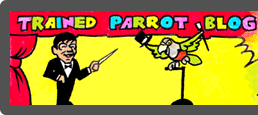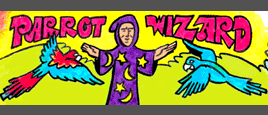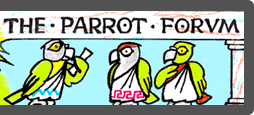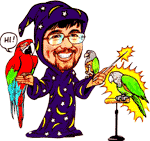Michael wrote:I took a look at the article and see where it is coming from about VR not being necessary for the basic dog owner teaching tricks to their dog. There is a substantial difference when it comes to parrots that makes me disagree that VR isn't necessary for most pet owners. Parrots are naturally wild animals so except for the positive reinforcement taming and training that we give them, they are difficult to handle. In order to get our parrots to step up reliably, come out of the cage, flight recall to us, not bite us, etc we cannot keep giving treats every single time or the parrot will be stuffed with treats in the first 5 minutes it spends with us. The more good behavior that we can move to a diluted variable ratio reinforcement schedule, the more domesticated the parrot's behavior appears to be.
This is a good point, training a wild animal (such as a parrot) is very different from training a domesticated animal such as a dog. A dog is more likely to want to please its owner whereas a parrot is not motivated to "people please" and unless it is hungry enough to be motivated by treats it loses interest.
You definitely get a lot more out of a parrot when rewarding on a VR. For example, if I am doing a session with my GCC and he gets full, he just flies away. I try to anticipate this and end the session before he loses interest but sometimes I miscalculate and he just flies off. You're not really going to have that problem with a dog since it doesn't have wings, but good luck chasing down a flighted bird and trying to get it to train once it's full.
Michael wrote:As a side effect it has also taught my parrot to try harder when training new behavior. Sometimes the behavior I am soliciting in training something new just isn't click-worthy for a while. Since my parrot is used to clicks confirming all correct behaviors, it makes her realize she is doing things wrong and makes her keep trying to get it right. Better yet, since she is so accustomed to training in this manner, she even varies the behaviors she offers until it's right enough to earn a click.
I've experienced something like this when training my Poi. When I was training "wings" I used capturing so at first it was just him lifting his wings at the shoulder, folded. I wanted him to extend his wings but after a month of working on it I wasn't seeing any progress whatsoever. I decided I'd withhold the click until I got even a tiny amount more. When he didn't get a click after a few tries he varied the behavior and really surprised me with a complete lateral wing stretch. I was only looking for a tiny stretch so that was far more than I was expecting! I clicked and made a big deal out of it and offered him a jackpot reward. When I cued "eagle" again he initially offered the folded shoulder lift but when that didn't get a click after he tried it twice, he fully stretched his wings out laterally again on the third try. The next time I cued eagle he immediately did the lateral stretch.
I know you could get the similar results in shaping with a bird that wasn't used to the clicker as CFR and food as VR but I don't know if you could get them as quickly, nor do I think the bird would vary its behavior so readily.







